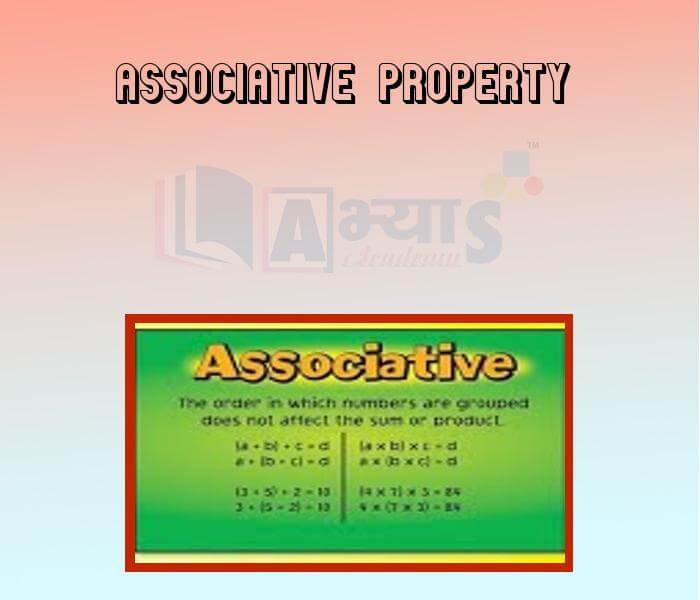Associative Property





Associative Property
It states that you can add or multiply numbers regardless of how they are grouped. In both the groups the sum is the same. Addition and multiplication are associative for rational numbers. Subtraction and division are not associative for rational numbers.
Rational numbers follow the associative property for addition and multiplication.
Suppose x, y and z are rational then for addition: x+(y+z)=(x+y)+z
For multiplication: x(yz)=(xy)z.
An important properties that should be remembered are:
0 is an additive identity and 1 is a multiplicative identity for rational numbers.
Associative Property of Addition in Rational Numbers:
The addition of rational numbers is associative i.e. if are any three rational numbers, the
Verification: In order to verify this property, let us consider three rational number and if the following expression holds true so we can say that addition supports associativity
The left hand side of the expression can be simplified as
=
and, the right hand side of the expression can be simplified as
Similarly, it can be verified for other rational numbers.
Hence, associative property is true under addition.
Associative Property of Subtraction in Rational Numbers:
The subtraction of rational numbers is not associative, i.e. for any three rational numbers we have
Verification: In order to verify this property, let us consider three rational number and if the following expression holds true so we can say that subtraction does not support associativity.
The left hand side of the expression can be simplified as
and, the right hand side of the expression can be simplified as
Hence LHS RHS
Hence Associative property is not true for subtraction of rational numbers
Associative Property of Multiplication in Rational Numbers:
The multiplication of rational numbers is associative. That is, if are three rational numbers, then
Verification: In order to verify this property, let us consider three rational number and if the following expression holds true so we can say that multiplication supports associativity
The left hand side of the expression can be simplified as
and, the right hand side of the expression can be simplified as
Hence LHS = RHS
Hence, associative property is true under multiplication.
Associative Property of Division in Rational Numbers:
The division of rational numbers is not associative. That is, if are three rational numbers, then
Verification: In order to verify this property, let us consider three rational number and if the following expression holds true so we can say that division does not support associativity
The left hand side of the expression can be simplified as
and, the right hand side of the expression can be simplified as
Hence LHS RHS
Hence Associative property is not true for division of rational numbers
For every non-zero rational number , we have
The division of rational numbers is neither commutative nor associative.
Which of the following is an example of the Associative Property of Multiplication? | |||
| Right Option : C | |||
| View Explanation | |||
What is the value of x and y? in | |||
| Right Option : D | |||
| View Explanation | |||
7 + (a + 2) = (7 + a) + 2 , is explained by which property? | |||
| Right Option : D | |||
| View Explanation | |||
Students / Parents Reviews [10]
I have spent a wonderful time in Abhyas academy. It has made my reasoning more apt, English more stronger and Maths an interesting subject for me. It has given me a habbit of self studying

Yatharthi Sharma
10thBeing a parent, I saw my daughter improvement in her studies by seeing a good result in all day to day compititive exam TMO, NSO, IEO etc and as well as studies. I have got a fruitful result from my daughter.

Prisha Gupta
8thAbhyas is a complete education Institute. Here extreme care is taken by teacher with the help of regular exam. Extra classes also conducted by the institute, if the student is weak.

Om Umang
10thMy experience was very good with Abhyas academy. I am studying here from 6th class and I am satisfied by its results in my life. I improved a lot here ahead of school syllabus.

Ayan Ghosh
8thA marvelous experience with Abhyas. I am glad to share that my ward has achieved more than enough at the Ambala ABHYAS centre. Years have passed on and more and more he has gained. May the centre flourish and develop day by day by the grace of God.

Archit Segal
7thAbout Abhyas metholodology the teachers are very nice and hardworking toward students.The Centre Head Mrs Anu Sethi is also a brilliant teacher.Abhyas has taught me how to overcome problems and has always taken my doubts and suppoeted me.

Shreya Shrivastava
8thMy experience with Abhyas is very good. I have learnt many things here like vedic maths and reasoning also. Teachers here first take our doubts and then there are assignments to verify our weak points.

Shivam Rana
7thMy experience with Abhyas academy is very good. I did not think that my every subject coming here will be so strong. The main thing is that the online tests had made me learn here more things.

Hiya Gupta
8thIt has a great methodology. Students here can get analysis to their test quickly.We can learn easily through PPTs and the testing methods are good. We know that where we have to practice

Barkha Arora
10thIt was a good experience with Abhyas Academy. I even faced problems in starting but slowly and steadily overcomed. Especially reasoning classes helped me a lot.
